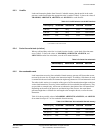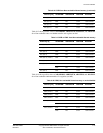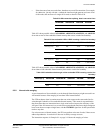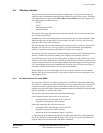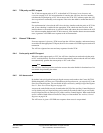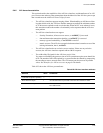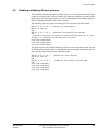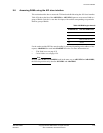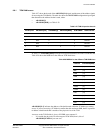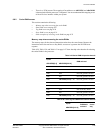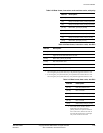
Level Two Interface
ARM DDI 0363E Copyright © 2009 ARM Limited. All rights reserved. 9-21
ID013010 Non-Confidential, Unrestricted Access
9.4.2 TCM parity and ECC support
The TCMs can support parity or ECC, as described in TCM internal error detection and
correction on page 8-14. If a write transaction is issued to the AXI slave, the slave interface
calculates the required parity or ECC bits to store to the TCM. ECC schemes require the AXI
slave to perform a read-modify-write sequence if the write data width is smaller than the ECC
chunk size.
If a read transaction is issued to the AXI slave, the slave interface reads the parity or ECC bits
and, if error checking is enabled for the appropriate TCM, checks the data for errors. If the
interface detects a correctable error, it corrects it inline and returns the correct data on the AXI
bus. It does not update the data in the TCM to correct it. If the interface detects an uncorrectable
error, it generates a SLVERR error response to the AXI transaction.
9.4.3 External TCM errors
If an error response is given to a TCM access from the AXI slave interface, and external errors
are enabled for the appropriate TCM port, the AXI slave returns a SLVERR response to the AXI
transaction.
The AXI slave ignores late-error and retry responses from the TCM.
9.4.4 Cache parity and ECC support
When the caches support parity or ECC, the AXI slave interface can read and write the parity
or ECC code bits directly. No errors are detected automatically, and on writes the AXI slave does
not automatically generate the correct parity or ECC code values.
Note
The AXI slave interface provides read/write access to the cache RAMs for functional test. It is
not suitable for preloading the caches.
9.4.5 AXI slave control
By default, both privileged and non-privileged accesses can be made to the Cortex-R4 TCM
RAMs through the AXI slave port. To disable non-privileged accesses, you can set bit [1] in the
Slave Port Control Register. You can disable all slave accesses by setting bit [0] of the register.
See c11, Slave Port Control Register on page 4-59.
Access to the cache RAMs can only be made when bit [24] of the Auxiliary Control Register is
set. By default, only privileged accesses can be made to the cache RAMs, but you can enable
non-privileged accesses by setting bit [23] of the Auxiliary Control Register. When cache RAM
access is enabled, both caches are treated as if they were not enabled. See Auxiliary Control
Registers on page 4-38.
The AXI access is given a SLVERR error response when access is not permitted.



